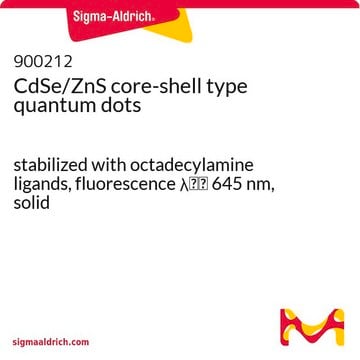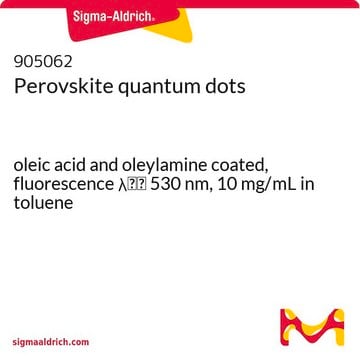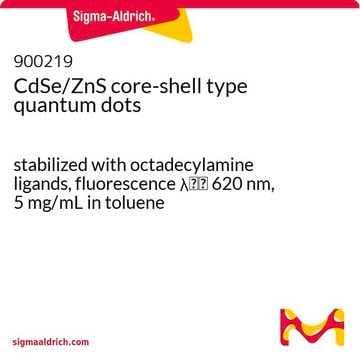The weight percentage of octylamine ligands compared to the quantum dots is not determined for this product.
790192
CdSe/ZnS core-shell type quantum dots
stabilized with octadecylamine ligands, fluorescence λem 620 nm, solid
Sinónimos:
Artificial atoms, Fluorescent nanocrystals, QDs
Seleccione un Tamaño
369,00 €
Seleccione un Tamaño
About This Item
369,00 €
Productos recomendados
Formulario
solid
fluorescencia
λem 620 nm
¿Está buscando productos similares? Visita Guía de comparación de productos
Categorías relacionadas
Aplicación
Protocol to make QD solutions (dispersing QDs into solutions):
1. Weigh desired amount of the quantum dot powder and put it in a glass vial;
2. Add desired amount of the solvent, i.e. toluene, chloroform, hexane, etc. (mostly non-polar organic solvents) in the vial and shake the vial;
3. If there is any solid left in the vial after shaking, sonicate the vial for 30~60 seconds to get the quantum dot powder well dispersed. If required dilute the solution further.
Material has a shelf life of around 3 years if stored properly. Store at room temperature (4-25 °C); do not freeze. Should not be exposed to extreme temperatures.
Información legal
Palabra de señalización
Danger
Frases de peligro
Consejos de prudencia
Clasificaciones de peligro
Acute Tox. 4 Inhalation - Acute Tox. 4 Oral - Aquatic Acute 1 - Aquatic Chronic 1 - Eye Dam. 1 - Skin Irrit. 2 - STOT RE 2 - STOT RE 2 Oral
Órganos de actuación
Kidney,Bone, Liver,Gastrointestinal tract,Immune system
Riesgos supl.
Código de clase de almacenamiento
11 - Combustible Solids
Clase de riesgo para el agua (WGK)
WGK 3
Punto de inflamabilidad (°F)
Not applicable
Punto de inflamabilidad (°C)
Not applicable
Listados normativos
Los listados normativos se proporcionan para los productos químicos principalmente. Para los productos no químicos sólo se puede proporcionar información limitada. Si no hay ninguna entrada, significa que ninguno de los componentes está en la lista. Es obligación del usuario garantizar el uso seguro y legal del producto.
EU REACH Annex XVII (Restriction List)
Elija entre una de las versiones más recientes:
¿Ya tiene este producto?
Encuentre la documentación para los productos que ha comprado recientemente en la Biblioteca de documentos.
Los clientes también vieron
Artículos
Quantum dots are tiny particles or nanocrystals of a semiconducting material with diameters in the range of 2-10 nanometers.
Dye-sensitized solar cells as a promising, low-cost photovoltaic technology.
Professor Sharma and colleagues review the synthesis and applications of this novel material. This includes a discussion of the unique properties of quantum dots and their suitability for solar cell applications, along with common synthesis techniques used to develop these materials.
Professor Xiaohu Gao (University of Washington, USA) provides a overview of recent quantum dot (QD) advancements and their potential for advancing bioassay and bioimaging technologies.
-
Wonder what is the percentage of weight is the octylamine ligands compared to the QDs?
1 respuesta-
¿Le ha resultado útil?
-
-
What is the particle density for product 790192, CdSe/ZnS core-shell quantum dots?
1 respuesta-
The particle density is not determined for this product.
¿Le ha resultado útil?
-
-
What is the molecular weight of CdSe/ZnS core-shell type quantum dots, and what is the recommended method for their dissolution?
1 respuesta-
The molecular weight information for CdSe/ZnS core-shell type quantum dots is typically not provided in the QD field, as it can be calculated based on the quantum effect via size. The recommended solvents for dissolving CdSe/ZnS core-shell type quantum dots include chloroform, toluene, xylene, and THF. The procedure for dissolution involves adding the solvent to the QD solid, shaking it for 3 minutes, and sonication for 20 seconds if the QDs are not completely dispersed. If toluene is the solvent, any grade of toluene can be used. No specific equipment is needed for dissolving CdSe/ZnS core-shell type quantum dots; shaking the vial is sufficient.
¿Le ha resultado útil?
-
-
What is the Department of Transportation shipping information for this product?
1 respuesta-
Transportation information can be found in Section 14 of the product's (M)SDS.To access the shipping information for this material, use the link on the product detail page for the product.
¿Le ha resultado útil?
-
-
What is the particle size and shell size for product 790192, CdSe/ZnS core-shell quantum dots?
1 respuesta-
The particle size of the core and shell is about 8 nm and that of the surface ligand is 2 nm.
¿Le ha resultado útil?
-
Filtros activos
Nuestro equipo de científicos tiene experiencia en todas las áreas de investigación: Ciencias de la vida, Ciencia de los materiales, Síntesis química, Cromatografía, Analítica y muchas otras.
Póngase en contacto con el Servicio técnico


![(Ir[dF(CF3)ppy]2(dtbpy))PF6](/deepweb/assets/sigmaaldrich/product/structures/982/913/02dd8ddd-6deb-40a0-ab9b-07b18f1abb09/640/02dd8ddd-6deb-40a0-ab9b-07b18f1abb09.png)










